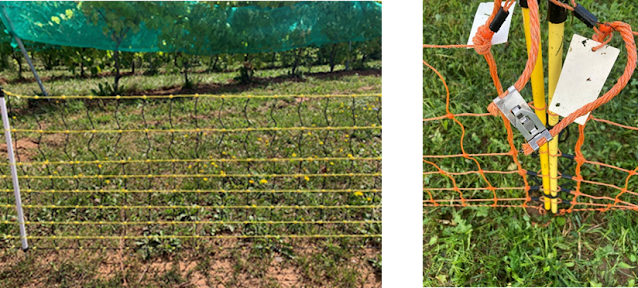This week, Jeff Franklin from AAFC Kentville is sharing with us weather information with quite positive values of growing degree values. Veraison started since the middle of August in the earliest hybrids and currently it’s possible to see many vineyards with grapes changing colors and ripening. With the grapes already ripening it’s important to remind to protect the fruit zone to diminish the damage by nature.
The first table shows the temperature base 5⁰ C and 10⁰ C from 2019 until 2022 accumulated from March 1 until September 6. At the end of each section, it’s possible
to see the average of the last 5 and 10 years respectively.
|
Category |
2019 |
2020 |
2021 |
2022 |
5 year average |
10 year average |
|
Plant development
(Base 5ºC) |
1565.1 |
1686.6 |
1744.3 |
1759.5 |
1672.7 |
1680.7 |
|
Insect development
(Base 10º) |
917.4 |
1056.2 |
1057.6 |
1077.4 |
1016.7 |
1021.3 |
Figure 1. Degree day accumulations as of September 6, 2022. All data are taken from the Kentville weather
station, based on a start date of March 1, and calculated using the single sine
method.
At this time, we can see 2022 with values higher than 2021. Compared
to the 5- and 10-year average, 2022 maintains a considerable higher
accumulation of degrees. The increase of degree accumulation combined with the
lower amount precipitation has triggered that some grapevines, hybrids and Vitis
vinifera varieties, accelerated their phenology compared previous years.
Therefore, take a look at your records as harvest, as it looks quite similar to
the previous seasons.
In the following
column graph, you can see the values from 2005 until 2022 and at the end the
average of the last 5 and 10 years respectively.
Figure 2. Degree day accumulations as of September 6, 2022 base 10⁰ C. All data are taken from the
Kentville weather station, based on a start date of March 1, and calculated
using the single sine method.
Already mentioned in the previous table, 2022 the
accumulation is higher than previous seasons and it is higher than the 5- and
10-year average. Compared to previous seasons, 2021, 2020 and 2018 are very
similar than the current season and only overpassed by the season 2006. Take a
look at your records of how the previous seasons were to be prepared for
harvest and have an active communication with the wineries on how they plan to
proceed.
Veraison started in
the middle of August with the earliest hybrids turning color, such as Baco noir
and Castel, and now even the latest Vitis vinifera varieties, like
Riesling, are reaching at this phenological stage. The combination of warm
temperatures and less precipitation have impacted the grapevines accelerating
the ripening process, which is something important to consider as harvest will
approach soon. It’s highly recommended to keep an eye on how nature might
impact your crop and it’s important to have the fruit zone protected to
diminish damage.
Figure 3. On the left Petite Pearl and on the right L’Acadie
blanc.
Figure 4. On the left Chardonnay
and on the right Pinot noir.
Most frequently used grape protection strategies in Nova
Scotia are netting, fences, sonic devices, kites and combination of these.
One of the most common ways to protect the bunches is the
netting. The nets are placed in a way that the fruit zone is covered from the
top of the bunches until below the first wire. In some cases, nets can be
placed in a way that they cover 2 rows completely at a time. Regardless of the
coverage method selected, it’s important to ensure proper coverage of the fruit
zone. It’s necessary to fasten the edges of the nets with staples/clips/pegs,
to prevent birds or racoons from entering inside.
Figure 5. Vineyard during the process of netting the
fruit zone.
Electric fencing is used as a strategy to prevent raccoons
from visiting the grapevines. For the most efficient results, protecting the
entire perimeter of the property is necessary. Moreover, to ensure the correct
voltage along the whole fence, the area where the wires are located must be
connected properly. Making some measurements prior to setting up the fence is
recommended. Keeping the area clean from weeds will prevent short circuiting
and allow the proper functioning of the electric fence. Also, it is important
to connect properly the fences to have a good protection throughout the
perimeter.
Figure 6. Electric fence protecting the perimeter of
the vineyard and the connection between two fences.
Sound repellents that are used to help with the protection
of the vineyard include sonic devices and cannons. Please, take a look at the
previous publication to read more about Nova
Scotia Sonic Device Policy - Wildlife Deterrent.
Figure 7. Kite combined on the left with netting and
on the right with a sonic device.
Last, but not least, at this time it’s important to track grape ripening to help taking harvest decisions and inform to the winery on how the maturity is moving along in your vineyard. Remember, the results will be as good as the sampling performance. The sampled grapes need to be representative of the plot that they are coming from. It’s a good idea to collect a minimum of 100 berries from a specific variety and repeat in the same area(s) to be able to track the ripening process. Finally, Alab from Acadia University provides analytical services for grape ripening, please take a look at the lab webpage for more information https://alab.acadiau.ca/wine.html







